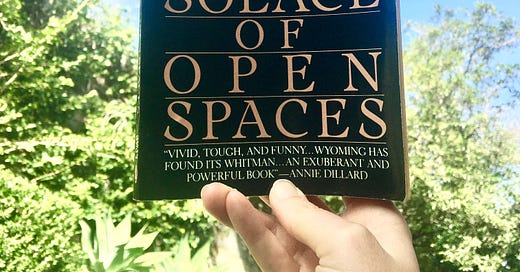Hi! I’m Hannah James, journalist, writer and editor, and this is where I review nature books, and think about nature-related topics out loud. Thanks for reading!
What I’m reading
I missed you last week - I was in Tasmania on a last-minute work trip, eating and drinking my way around Hobart. Friends, it was wonderful.

In the brief intervals between eating, I… well, I wasn’t doing all that much reading, either. But I did fly through Gretel Ehrlich’s The Solace of Open Spaces.
In 1976, Ehrlich and her partner, both 29 and living in New York, were told by doctors that he was dying. But they had already been commissioned to make a film about sheepherders in Wyoming, and so she went anyway, alone. As you’ll know if you’re familiar with her work, that trip made her into the revered poet of the West she is today. She never lived in New York again.
This book, Ehrlich’s first, is a series of essays about Wyoming that cover not so much the tragedy that sent her there, but more the people she meets, the animals she works with and, most of all, the land she lives on. She talks about the life-blood of water in a dry landscape; the ritual of rodeo; the iconic image of the strong and silent cowboy (which “has perverted manliness into a self-absorbed race for cheap thrills.… the westerner’s courage is [actually] selfless, a form of compassion”); the nature of people’s relationships with animals, who see “what’s bedrock and current in us: aggression, fear, insecurity, happiness, or equanimity… we’re transparent to them and thus exposed - we’re finally ourselves”.

We get all the hair-raising stories of life on isolated ranches we could wish for. There’s a cowboy who is badly injured while alone at a remote camp, and so scratches an SOS with the point of a bullet onto leather cut from his chaps. Then he ties the message to his horse and sends it away to find help. A rancher dies from gangrene after falling from his horse and using an old remedy on his crushed leg: horse manure. A no-nonsense female farmer solves the problem of her neighbour grazing his cows on her land by shooting the hat right off his head and telling him it would be hanging on her mantelpiece if he wanted to retrieve it. (He did not.)

But Ehrlich is no tourist gleefully relating funny, freaky stories about these odd characters. She makes it clear she’s one of them, as she mucks in to do the hard and solitary work of a sheepherder, then learns how to be a cowboy. She becomes friends with these work- and weather-hardened, practical, yet unstintingly generous people. In a sparsely populated place, she learns:
“A person’s life is not a series of dramatic events for which he or she is applauded or exiled but a slow accumulation of days, seasons, years, fleshed out by the generational weight of one’s family and anchored by a land-bound sense of place.”
These land-bound people are laconic: “Conversation goes on in what sounds like a private code... Sentence structure is shortened to the skin and bones of a thought.” And Ehrlich connects this trait to precisely the fact that they are land-bound:
“Instead of talking, we seem to share one eye. Keenly observed, the world is transformed. The landscape is engorged with details, every movement on it chillingly sharp… Days unfold, bathed in their own music. Nights become hallucinatory; dreams, prescient.”
And although her friends and neighbours are a joy to get to know, it’s in those details of the landscape that Ehrlich truly shines.
“Morning. Sagesmell, sunsquint, birdsong, cool wind.”
“Most characteristic of the state’s landscape is… waterless stands of salt sage, snakes, jack rabbits, deerflies, red dust, a brief respite of wildflowers, dry washes and no trees… the doing of a mad architect - tumbling and twisted, ribboned with faded, deathbed colours, thrust up and pulled down as if the place had been started out of a deep sleep and thrown into a pure light.”
The open space of the ranges can send you mad, but it can also set you free. It did in fact provide the solace Ehrlich was seeking.
“I suspect that my original motive for coming here was to ‘lose myself’ in new and unpopulated territory. Instead of producing the numbness I thought I wanted, life on the sheep ranch woke me up. The vitality of the people I was working with flushed out what had become a hallucinatory rawness inside me. I threw away my clothes and bought new ones; I cut my hair. The arid country was a clean slate. Its absolute indifference steadied me.”
The Solace of Open Spaces was book 44 for 2021. I’ve also been reading:
Sarah Orne Jewett, A Country Doctor
Margaret Kennedy, The Constant Nymph
Barbara Kingsolver, The Lacuna
One final pic of my amazing trip to Hobart to explain why I wasn’t doing much reading:

Thanks again for reading! Feel free to hit reply to this email to have a chat (I always write back!), press the heart button if you liked this, or comment.
Also! Follow me on Instagram @hannahjameswords, on Twitter @hannahjamesword and check out my website at hannahjameswords.com.





